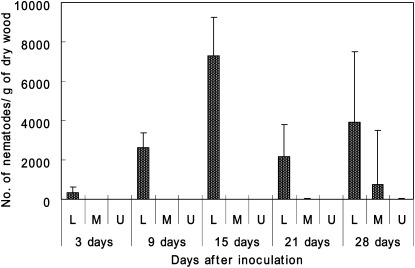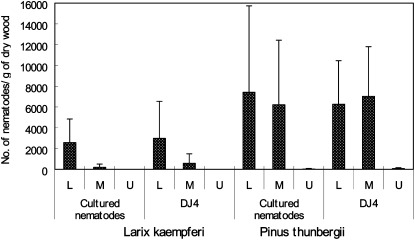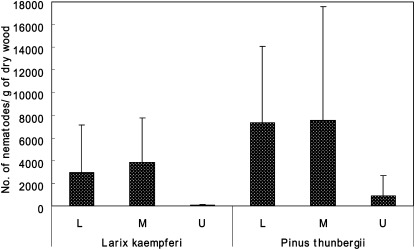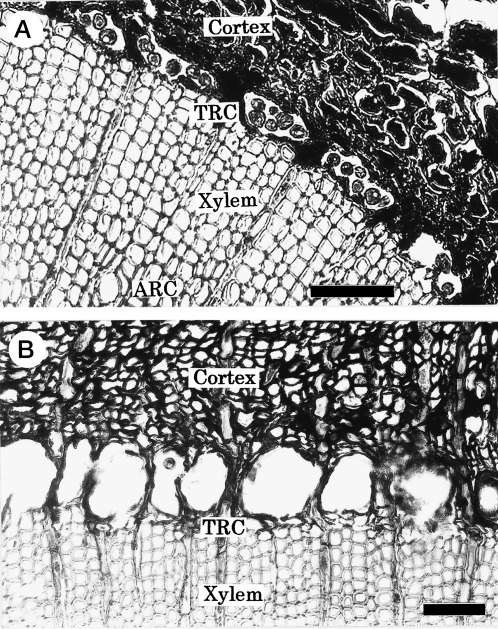Abstract
Pathogenicity of the pine wood nematode, Bursaphelenchus xylophilus, to Japanese larch, Larix kaempferi, seedlings was tested with inoculation experiments under nursery conditions. Water suspensions of nematodes (mixed stages cultured on Botrytis cinerea or dispersal fourth-stage juveniles (DJ4) extracted from the adult Japanese pine sawyer, Monochamus alternatus) were injected into the stems of 2- and 3-year-old Japanese larch and Japanese black pine, Pinus thunbergii, seedlings growing in a nursery. In another treatment, Japanese pine sawyer adults holding DJ4 were released under a net that covered the upper half of the seedlings. Regardless of nematode inoculation method, Japanese larch seedlings were as susceptible as Japanese black pine seedlings to B. xylophilus under nursery conditions. The rate of disease development was similar on larch and pine seedlings. Nematode population densities were lower in the stems of dead larch seedlings than in the stems of dead pine seedlings. Histopathological observations revealed that the distribution of nematodes in the stems of dead larch seedlings was mostly limited to the cortex, phloem and cambial zone. Traumatic resin canal formation was one of the most characteristic symptoms in larch seedlings which was dissimilar to that in pine seedlings.
Keywords: Bursaphelenchus xylophilus, inoculation, Larix kaempferi, maturation feeding, Monochamus alternatus, pathogenicity, Pinus thunbergii
After being introduced to Japan from overseas, maybe from North America, in the early 1900s, the pinewood nematode, Bursaphelenchus xylophilus (Steiner & Buhrer) Nickle, has spread throughout Japan and in many other countries, China, South Korea, Taiwan and Portugal and has caused devastating damage to pine trees in the form of pine wilt disease (pinewilt). Annual loss caused by pinewilt was estimated 700,000 m3 of pine wood, or about 5 million pine trees, in Japan. In the last 3 decades, pinewilt has spread markedly, especially from the southwest and central parts of Japan to the northeast and to pine forests distributed at higher elevations (Mamiya, 2004). As a result of the spread of pinewilt to these areas, nearby larch forests have been threatened with infection by B. xylophilus. Japanese larch, Larix kaempferi, was extensively planted in the 1950s and 1960s throughout northeastern Japan and in the high lands of central Japan to provide wood resources. The total area of planted and managed larch forests in Japan is 1.1 million ha.
In Japan natural infection of larch trees by B. xylophilus has not been detected in larch plantations, although evidence suggested that the nematode had naturally infected 10-year-old larch trees in the experimental forest in Ibaraki Prefecture (Mamiya and Shoji, 1985). In the United States, Bergdahl (1982) extracted B. xylophilus from dead and dying eastern larch (Larix laricina) in Vermont. In Japan it is conceivable that pinewilt will spread to larch forests, especially to those forests located adjacent to pine forests severely affected with pinewilt. To estimate the potential damage to larch forests that may be caused by pinewilt in the future, detailed information about the susceptibility of larch to B. xylophilus is required.
Pathogenicity of B. xylophilus to Larix spp. has been tested by inoculation (Ando et al., 1986; Bergdahl, 1982; Futai and Sutherland, 1989; Ogura, et al., 1983; Tanaka, 1978). Results demonstrated that mortality of inoculated seedlings was rather high, although mortality in each test depended on temperature and other experimental conditions.
The objective of this study was to examine how pathogenicity of B. xylophilus to larch seedlings under nursery conditions is affected by two inoculation methods. Inoculation was achieved by injecting nematode suspensions directly into seedlings or by releasing adult Japanese pine sawyers (JPS), Monochamus alternatus Hope, which held the dispersal fourth-stage juveniles (DJ4) of B. xylophilus, for maturation feeding on seedling branches. There had been little information about maturation feeding of JPS on larch branches, therefore, to evaluate the possibility of transmission of B. xylophilus to larch by JPS, maturation feeding tests were conducted. Disease development of inoculated seedlings and population densities of B. xylophilus in the seedlings were quantified. Although the experiments were conducted in 1984, as the risk of pinewilt spreading to larch forests in Japan has greatly increased since that time, the authors believe that publication of these data is now essential and current.
Materials and Methods
Larch seedlings: Larch seedlings were transplanted and grown in a nursery located at the Forestry and Forest Products Research Institute in Tsukuba, Ibaraki Prefecture, Japan. Two- and 3-year-old larch seedlings were used for the inoculation experiments. As a positive control, 3-year-old Japanese black pine seedlings (Pinus thunbergii) grown in the same nursery were included in the inoculation experiments. The seedlings were planted in rows, each row containing one kind and age of seedling and receiving one kind of treatment. The seedling height and stem diameter at the start of the experiment are shown in Table 1.
Table 1.
Characteristics of seedlings at time of inoculation.
Nematode: Bursaphelenchus xylophilus (strain S-10 collected in Shimane, Japan) was monoxenically cultured on the fungus Botrytis cinerea grown on barley grains. Nematodes were separated from the culture medium by the Baermann funnel technique. A water suspension of nematodes was adjusted to a concentration of 105 nematodes/ml of tap water.
Dispersal fourth-stage juveniles of B. xylophilus were extracted from 25 adult JPS collected from dead pine logs affected with pinewilt in Chiyoda, Ibaraki Prefecture; a mean of 17,000 DJ4 was obtained from each adult. A tap water suspension of the DJ4 (105 DJ4/ml) was prepared as described for the cultured nematodes.
Nematode inoculation using a water suspension: Seedlings were inoculated with a water suspension (0.1 ml) of cultured or DJ4 nematodes (10,000/seedling). The suspension was pipetted into a wound (3 cm long by 2 cm wide), formed in the stem 30-50 cm above the ground. The wound was made by cutting and peeling back the bark to expose the xylem. After the suspension was added to the wound, the bark was replaced. Three-year-old larch and pine seedlings were inoculated on 28 June 1984 with suspensions of cultured and DJ4 nematodes, and 2-year-old larch seedlings were inoculated on 24 July, 1984 with suspensions of cultured nematodes. The number of seedlings inoculated for all treatments are indicated in Table 2. A water control was included for the 3-year-old larch and pine seedlings (Table 2).
Table 2.
Mortality of seedlings inoculated with Bursaphelenchus xylophilus as affected by seedling species, age of larch seedlings and methods of inoculation.
Nematode inoculation through Japanese pine sawyer adult maturation feeding: From 16 to 19 June, 1984, JPS adults were collected from dead pine logs affected with pinewilt in Chiyoda, Ibaraki Prefecture. The JPS adults were reared on healthy pine twigs until they were added to seedlings. On 28 June, 1984, one adult male or female JPS was added to each seedling covered with a net (Sarannet, Asahi Kasei Co., Tokyo, Japan) that confined the JPS to the seedling. Numbers of DJ4 held by a JPS adult were estimated by extracting nematodes from 20 JPS adults. The mean and maximum number of DJ4/adult JPS was 17,000 and 68,000 DJ4, respectively and only one of the 20 adults contained no DJ4. After 12 days, the adults and the nets were removed from the seedlings and the number and the total length of wounds made by JPS maturation feeding were determined for each seedling. Nematode-free JPS adults were used as a control. The nematode-free adults were obtained by rearing larvae in vials to the pupal and then the adult stage. During late April to early May, 1984, the fourth instar larvae were collected from dead pine logs. Each larva was kept in a vial with a piece of moistened rectangular filter paper until emergence. Even though pine logs were infested with B. xylophilus, adults were nematode free.
Disease development: The seedlings were examined weekly for disease symptoms, which included wilting leaf discoloration and leaf fall. Seedling mortality also occurred, and the mortality rate of inoculated seedlings was determined on 10 September, 1984, for 3-year-old larch and pine seedlings and on 26 August, 1984, for 2-year-old larch seedlings.
Population densities of Bursaphelenchus xylophilus in diseased and dead seedlings: Nematodes were extracted from wood samples collected from nematode-inoculated 2-year-old larch seedlings at 6-day intervals. All 3-year-old dead larch and pine seedlings were collected on 10 September, 1984. At each sampling time except 3 days after inoculation, 2-year-old larch seedlings which showed external symptoms such as yellowing, wilting and falling leaves were chosen for nematode extraction. Three days after inoculation seedlings were collected at random. Stem sections (10-cm long) were cut from collected seedlings at each of the following positions: upper part (the main shoot), middle part (including the nematode inoculation point), and lower part (10 cm above ground level). Stem samples were sliced thin and placed on Baermann funnels to extract nematodes. After air drying for 3 days, each stem sample was dried for 8 h at 120 °C and weighed. The number of B. xylophilus was converted to the number/g dry wood.
Histopathological observations of nematode inoculated larch seedlings: Wood segments (1-cm long) were collected from the lower and the middle part of each 2-year-old larch seedling at the same time that wood samples were collected for nematode extraction. Segments were fixed in FPA (formalin-propionic acid-alcohol), dehydrated, embedded in paraffin, and cut into 12- μm-thick sections with a sliding microtome. The sections were double-stained with safranin and fast green and then observed with a light microscope.
Data analysis: Nematode density data were subjected to analysis of variance (ANOVA) and means were separated according to the least significant difference test (P ≤ 0.05). The effect of seedling species on JPS feeding marks was inferred by comparisons of means and standard deviations (±SD).
Results
Temperatures at the experimental site: During June to September, 1984, the highest temperature recorded at the nursery was 27.6 °C (in August) and the lowest temperature recorded was 20.4 °C (in June).
Disease development in 2-year-old larch seedlings: Disease symptoms were first observed 9 days after 2-year-old larch seedlings were inoculated with a water suspension of cultured nematodes. When cross sections of the stems were examined macroscopically, cortex tissues were brown and did not exude oleoresin. Some leaves were yellowing. Over the next several weeks, all the leaves on the inoculated seedlings began to fall and shoots were wilting and drooping. Almost all of the nematode-inoculated seedlings were dead within 1 month of inoculation (Table 2). Although there were no noninoculated 2-year-old larch seedlings, no mortality occurred among the 3-year-old seedlings inoculated with a water suspension lacking nematodes (Table 2).
Disease development in 3-year-old larch seedlings and pine seedlings: Most (> 69%) of the 3-year-old larch and pine seedlings inoculated with cultured nematodes or DJ4 died. Seedlings treated with one adult JPS for maturation feeding died at mortality rate of 38% for larch and 65% for pine. As noted earlier none of the control seedlings (inoculated with water suspensions lacking nematodes) died (Table 2).
The number and size of feeding marks made by JPS were similar on larch and on pine seedling branches (P > 0.05) (Table 3). Maturation feeding by JPS adults lacking DJ4 did not cause disease or death to either larch or pine seedlings (Table 2).
Table 3.
Feeding marks made by Monochamus alternatus on 3-year-old seedlings.
In the stem of inoculated but surviving 3-year-old larch seedlings traumatic resin canals (TRC) were observed along the new growth ring of the xylem as a result of cambium activity maintained after inoculation. No TRC were observed in the stems of dead pine seedlings.
Bursaphelenchus xylophilus population densities in diseased and dead seedlings: The population density of B. xylophilus recovered from wood samples from inoculated 2-year-old larch seedlings increased as disease symptoms developed (Fig. 1). The population density of nematodes was greater in the lower part of the stem than in the middle or upper parts at each sampling date except at 3 days after inoculation (P ≤ 0.05).
Fig. 1.
Population densities of Bursapelenchus xylophilus in the stems of 2-year-old larch seedlings inoculated with a water suspension of cultured nematodes (grown on Botrytis cinerea). L, M, and U indicate the lower, middle, and upper part of the stem, respectively. Values are means (±SD) of three seedlings at 3, 9, and 15 days; 12 seedlings at 21 days; and 21 seedlings at 28 days after inoculation.
Nematode population densities in dead 3-year-old larch and pine seedlings increased after the seedlings were inoculated with a suspension of cultured nematodes or DJ4 (Fig. 2). The nematode population density was greater in the lower part of the stem of larch seedlings than in the middle or upper parts (P ≤ 0.05). Although the number of nematodes did not differ in the lower part and the middle part of the stems of pine seedlings (P > 0.05), more nematodes were detected in the middle part of pine seedling stems than in the middle part of larch seedling stems (P ≤ 0.05).
Fig. 2.
Population densities of Bursaphelenchus xylophilus in the stems of dead 3-year-old larch and pine seedlings inoculated with a water suspension of cultured nematodes (grown on Botrytis cinerea) or DJ4 (dispersal fourth stage juveniles obtained from JPS beetles). L, M, and U indicate the lower, middle, and upper part of the stem, respectively. Values are means (±SD) of 15 dead larch seedlings inoculated with cultured nematodes, 25 dead larch seedlings inoculated with DJ4, 9 dead pine seedlings inoculated with cultured nematodes, and 5 dead pine seedlings inoculated with DJ4.
Bursaphlenchus xylophilus population densities in dead larch seedlings inoculated by maturation feeding of JPS adults were similar to those in dead seedlings inoculated with nematode suspension (Fig. 3). However, nematode population densities did not differ between the lower part and the middle part of the stems (P > 0.05).
Fig. 3.
Population densities of Bursaphelenchus xylophilus in the stems of dead 3-yrear-old larch and pine seedlings inoculated with nematodes through the maturation feeding of JPS adults. L, M, and U indicate the lower, middle, and upper part of the stem, respectively. Values are means (±SD) of nine dead larch seedlings and 12 dead pine seedlings. Bars indicate standard errors of the mean.
Histopathological observations of diseased and dead 2-year-old larch seedlings: The formation of TRC was a characteristic seedling response to B. xylophilus inoculation. Traumatic resin canals were first observed on cross sections of the stems of larch seedlings inoculated with nematodes 15 days after inoculation. They were formed along the whole cambium layer in the cross field and extended up and down the stem from the inoculation point. Nematodes were observed in TRC formed along the cambium (Fig. 4). At the early stage of nematode infection nematodes were located in the cortex and damaged cortical cells resulting in cavities and discoloration. Nematodes were also present in rays and resin canals of the xylem. Nematodes were less frequently observed in the xylem than in the cortex throughout the experiment.
Fig. 4.
Cross sections of a dead 2-year-old larch seedlings stem 15 days after nematode inoculation. Bursaphelenchus xylophilus is located in the traumatic resin canals (TRC) formed along the cambial zone. The parenchyma cells of TRC are completely destroyed. A: The lower part of the stem. B: The middle part of the stem. ARC is the axial resin canal. Scale bar is 100 μm.
Discussion
Larch seedlings were as susceptible as Japanese black pine seedlings to B. xylophilus under the nursery conditions of the present study. The results are consistent with those of previous inoculation experiments which evaluated the pathogenicity of B. xylophilus to larch seedlings (Ando, et al., 1986; Bergdahl, 1982; Futai and Sutherland, 1989; Ogura et al., 1983; Tanaka, 1978). Tanaka (1978) demonstrated that B, xylophilus caused high mortality of inoculated larch seedlings growing in a growth chamber at 25-30 °C but no mortality at 15-25 °C. Most inoculation tests have been conducted in growth chambers or greenhouses where temperatures exceeded 25 °C. One test which was conducted in a nursery surrounded by heavily damaged pine forests reported that inoculation with B. xylophilus caused high mortality of 5-year-old larch seedlings (Ogura et al., 1983). The current study, which was conducted under nursery conditions similar to those described by Ogura et al. (1983), also found that inoculation resulted in high seedling mortality. The annual mean temperature of both sites is higher than 12 °C.
Bursaphelenchus xylophilus was first reported to infect L. laricina (eastern larch) in the northeastern United States (Bergdahl, 1982). Japanese larch growing in plantations has also been shown to be infected by B. xylophilus in the United States (Bergdahl and Halik, 1987). In Japan, however, B. xylophilus has not been found in larch trees growing in natural forest stands, although B. xylophilus was found in dead and dying larch trees in an experimental forest located in an area of Japan where pinewilt was spreading (Mamiya and Shoji, 1985). The latter report is the only record of a natural infection of larch trees by B. xylophilus in Japan.
Larch forests in Japan are mostly located in cool areas or at higher elevations, where JPS, the most important vector of B. xylophilus, does not occur. The distribution of JPS is increasing, however, and JPS and pinewilt have been spreading to pine forests planted in northern parts of Japan where larch is commonly grown. Japanese larch is listed as a host tree species of JPS (Suzuki and Takiguchi, 1935). Although the host-parasite relationship between JPS and larch trees has not been studied in detail, the present study demonstrates that JPS feeds on branches of larch seedlings and transmits B. xylophilus, and that the transmitted nematodes can cause a high incidence of seedling death. This provides the first evidence that maturation feeding by JPS can transmit B. xylophilus to Japanese larch and thereby cause pinewilt to Japanese larch. The results support the possibility of disease spread to larch forests through transmission of B. xylophilus by JPS. Mortality rate of pine seedlings as a result of JPS maturation feeding was higher than that of larch seedlings. Because of limited information about the relationship of JPS with the larch, it is difficult to conclude whether this result is related with the different host preference of JPS for pine vs. larch.
The population dynamics of B. xylophilus were different in diseased larch seedlings than in diseased pine seedlings in that the wood of diseased and dead larch seedlings contained fewer nematodes than the wood of diseased and dead pine seedlings. Interestingly, in the stem of larch seedlings that had died following maturation feeding of JPS, the nematode numbers were similar in the middle part and the lower part of the stem. One explanation for the different densities in different parts of the stem is that nematode population densities in different parts of the seedling were affected by site of nematode invasion (the upper part via maturation feeding vs. the lower part via infection of a nematode suspension). The smaller population densities of B. xylophilus in larch wood than in pine wood has been demonstrated in previous papers (Ando, et al., 1986; Bergdahl, 1982; Futai and Sutherland, 1989), and this is corroborated by the distribution pattern of nematodes in the wood of larch and pine. Histopathological observations in the current study revealed that B. xylophilus in larch occured mostly in the bark, i.e., the phloem, cortex and cambium; again, this same distribution pattern has been reported (Ando, et al., 1986; Bergdahl and Smeltzer, 1981). In diseased and dead pine trees, however, B. xylophilus were commonly distributed not only in the bark but also in the xylem (Mamiya, 2008).
In the current study, inoculation of larch seedlings with B. xylophilus induced formation of TRC in the cambium. Although the current study did not include histopathology of infected pine seedlings, previous studies have not indicated this kind of response when pine seedlings are infected by B. xylophilus (Mamiya, 1985, 2008). We therefore infer that the formation of TRC in the cambium is a unique histopathological reaction to B. xylophilus invasion into larch wood tissues.
This study demonstrated the susceptibility of Japanese larch to B. xylophilus through inoculation experiments. A high possibility of transmission of the nematode to larch by JPS was also indicated through maturation feeding tests using JPS adults carrying B. xylophilus. We suspect that environmental conditions, especially temperature, have prevented the disease from occurring in larch forests until this time. Under the present circumstances in which pine wilt disease is spreading to cooler areas and higher elevations in Japan, it is important to prevent the disease from spreading from pine forests to adjoining larch forests. To achieve the purpose, an urgent research need is to determine the JPS with larch.
Footnotes
The authors thank Dr. H. Makihara, Forestry and Forest Products Research Institute, and Prof. R. Iwata, College of Bioresource Sciences, Nihon University, for their valuable comments on the relationship between JPS and Japanese larch. The authors also thank Dr. H. Kosaka, Forestry and Forest Products Research Institute, for providing meteorological data at the nursery, and Dr. B. A. Jaffee for valuable suggestions.
This paper was edited by Inga Zasada.
Literature Cited
- Ando I, Mamiya Y, Hirano K, Iida K. Population dynamics of the pine wood nematode in diseased Japanese larch seedlings. Annals of the Phytopathological Society of Japan. 1986;52:148. [Google Scholar]
- Bergdahl DR. Occurrence of the pinewood nematode in eastern larch. In: Appleby JE, Malek RB, editors. Proceeding of 1982 National Pine Wilt Disease Workshop. Champain: Illinois National History Survey; 1982. pp. 47–55. [Google Scholar]
- Bergdahl DR, Smeltzer DLK. Histological observations of Bursaphelenchus xylophilus in symptomatic tissues of Larix laricina and Pinus resinosa. Phytopathology. 1981;72:257. [Google Scholar]
- Bergdahl DR, Halik S. The pine wood nematode associated with conifer mortality in the northeastern United States. In: Wingfield MJ, editor. Pathogenicity of the pine wood nematode. St. Paul, Minnesota: The American Phytopathological Society; 1987. pp. 46–49. [Google Scholar]
- Futai K, Sutherland JR. Pathogenicity and attraction to host extracts of Canadian pinewood nematodes: studies with Scots pine, western larch, and black spruce seedlings. Canadian Journal of Forest Research. 1989;19:1256–1261. [Google Scholar]
- Mamiya Y. Initial pathological changes and disease development in pine trees induced by the pine wood nematode, Bursaphelenchus xylophilus. Annals of the Phytopathological Society of Japan. 1985;51:546–555. [Google Scholar]
- Mamiya Y. Pine wilt disease in Japan. In: Mota M, Viera P, editors. The pinewood nematode, Bursaphelenchus xylophilus. Proceedings of an International Workshop. University of Evora, Porutugal August 20–22, 2001. Nematology Monographs and Perspectives, Volume 1. Leiden, Brill: 2004. [Google Scholar]
- Mamiya Y. Histopathological observations of Bursaphelenchus xylophilus in symptomatic tissues of pinewood. In: Mota MM, Viera P, editors. Pine wilt disease: A world wide threat to forest ecosystems. Springer: Berlin; 2008. pp. 321–334. [Google Scholar]
- Mamiya Y, Shoji T. Pathogenicity of the pine wood nematode to Japanese larch. 6th Annual Meeting of the Japanese Forest Society; 1985. p. 94. (Abstr.). [Google Scholar]
- Ogura T, Kishi Y, Kondo H, Ebine S. Pathogenicity of the pine wood nematode, Bursaphelenchus xylophilus, to several Pinaceae species. Transactions of 94th Annual Meetings of the Japanese Forest Society; 1983. pp. 467–468. [Google Scholar]
- Suzuki M, Takiguchi H. Illustrated introduction of longicorn beetles. III. Kansai Konchu Zasshi. 1935;3:1–13. [Google Scholar]
- Tanaka K. Inoculation experiment with Bursaphelenchus lignicolus to Larix leptlepis. Transactions of 89th Annual Meetings of the Japanese Forest Society; 1978. pp. 293–295. [Google Scholar]









